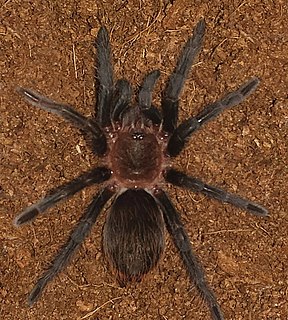
Brachypelma is a genus of spiders in the family Theraphosidae (tarantulas). They may have bodies up to 6 cm long with legs of similar or greater lengths. Some species have brightly colored legs, with red or orange marks and rings.

Chromatopelma is a monotypic genus of South American tarantulas containing the single species, Chromatopelma cyaneopubescens. Commonly known as greenbottle blue tarantulas due to their metallic blue legs and blue-green carapace, they are very active and fast-growing tarantulas that are particularly attractive to hobbyists. They are native to the Paraguaná Peninsula, near Punto Fijo.

Phormictopus is a genus of spiders in the family Theraphosidae (tarantulas) that occurs in the West Indies, mainly Cuba and Hispaniola, with three species probably misplaced in this genus found in Brazil and Argentina.
Aenigmarachne is a monotypic genus of tarantulas containing the single species, Aenigmarachne sinapophysis. It was first described by Günter E. W. Schmidt in 2005, and has only been found in Costa Rica.
Sickius is a genus of tarantulas. It has a single species, Sickius longibulbi. It is endemic to Brazil.
Hapalotremus martinorum is a species of tarantula in the subfamily Theraphosinae native to the High Yungas of Salta province, Argentina. It was first described in a 2015 publication by Patricio E. Cavallo and Nelson Ferretti.
Annandaliella ermakulamensis is a species of tarantula in the subfamily Selenogyrinae. It is one of three species in the genus Annandaliella and the first to be described in 73 years. It is native to Ermakulam, Kerala State, India.
Hapalotremus is a genus of South American tarantulas in the Theraphosinae subfamily that was first described by Eugène Louis Simon in 1903. They have red or white Type III urticating hairs, up to 1.2 millimetres (0.047 in), with a fine point and barbs along at least half of the lower part. The tibial apophysis is branched twice, and there is a conspicuous subapical keel on the male's embolus.
Bumba is a genus of tarantula native to the Americas. It is an uncommon genus, comprising only four known species, including one named after John Lennon. Like most related species in the subfamily Theraphosinae, they may flick urticating hairs in response to threats.
Munduruku bicoloratum is a theraphosid spider, endemic to Brazil, and is the only species in the monotypic genus Munduruku.
Bistriopelma is a genus of spider, being a theraphosine theraphosid (tarantula). It has two species as of February 2016, both of which are found in Peru.
Tmesiphantes yupanqui is a species of spider in the subfamily Theraphosinae of the family Theraphosidae. It is endemic to Argentina.
Tmesiphantes crassifemur is a species of theraphosine theraphosid spider. It is native to Argentina.
Orphnaecus is a genus of tarantulas that was first described by Eugène Louis Simon in 1892. They have close to fifty lanceolate stridulatory spines on the chelicerae, known as "strikers". The male embolus has a single strong retrolateral keel. It is considered a senior synonym of Chilocosmia and Selenobrachys.
Kochiana is a monotypic genus of Brazilian tarantulas containing the single species, Kochiana brunnipes. It was first described by C. L. Koch in 1841 under the name "Mygale brunnipes", and was transferred to its own genus in 2008. As of April 2020, it has only been found in Brazil.

Thrixopelma is a genus of South American tarantulas that was first described by Günter E. W. Schmidt in 1994.
Lasiodorides is a genus of South American tarantulas that was first described by Günter E. W. Schmidt & B. Bischoff in 1997.

Canalidion is a monotypic genus of tangle-web spiders containing the single species, Canalidion montanum. The species was first described by James Emerton in 1882 under the name Theridion montanum. J. Wunderlich moved it to its own genus in 2018, because it had more teeth on the anterior margin of the cheliceral furrow, a basal depression of the cymbium, and an embolus positioned dorsally. It has a holarctic distribution.
Tliltocatl andrewi is a possible species of spider in the family Theraphosidae (tarantulas). The World Spider Catalog regards it as a nomen dubium. Only the male has been described and its distribution is unknown.

Tliltocatl verdezi is a species of spiders in the family Theraphosidae (tarantulas), found in Mexico.





